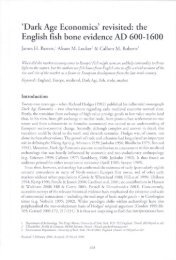Piracy in Late Roman Britain: A Perspective from the ... - Fiske Center
Piracy in Late Roman Britain: A Perspective from the ... - Fiske Center
Piracy in Late Roman Britain: A Perspective from the ... - Fiske Center
Create successful ePaper yourself
Turn your PDF publications into a flip-book with our unique Google optimized e-Paper software.
PIRACY IN LATE ROMAN BRITAIN: A PERSPECTIVE FROM THE VIKING AGE<br />
349<br />
envisaged as a defence - required a permanent garrison of considerable size. Davies, for<br />
example, estimates <strong>the</strong> Shore Forts garrison to have been between 2,000 and 3,000,79 a figure<br />
that does not take account of detachments around <strong>the</strong> coast of Wales and Nor<strong>the</strong>rn England, nor<br />
of militia with<strong>in</strong> maritime towns. In A.D. 300 <strong>the</strong> army of Brita<strong>in</strong> is estimated to have numbered<br />
about 25,000 and this was reduced <strong>in</strong> stages dur<strong>in</strong>g <strong>the</strong> fourth century.80 Given <strong>the</strong>se figures,<br />
<strong>the</strong> burden on military manpower seems out of step with <strong>the</strong> limited threat <strong>from</strong> raid<strong>in</strong>g that<br />
is proposed by this study. We must <strong>the</strong>refore assume that our piracy model is <strong>in</strong>correct, that<br />
garrisons did not comprise entire units, or that <strong>the</strong> forts were utilised for an entirely different<br />
purpose. Arguments are presented elsewhere for <strong>the</strong> Shore Forts be<strong>in</strong>g someth<strong>in</strong>g o<strong>the</strong>r than<br />
a maritime defensive scheme: tactical considerations, <strong>the</strong>ir piecemeal creation, a sparse and<br />
sporadic occupation history, and <strong>the</strong> illogical and early closure of several sites <strong>from</strong> <strong>the</strong> midfourth<br />
century, all po<strong>in</strong>t to a different conclusion.81 A primary logistical function has been<br />
proposed, although <strong>the</strong>re is noth<strong>in</strong>g to preclude a complementary (though perhaps secondary)<br />
role <strong>in</strong> coastal defence.<br />
Even <strong>the</strong> latter possibility may be belied by <strong>the</strong> forts' location. Villas have been suggested as<br />
prime targets of raid<strong>in</strong>g, but it is notable that <strong>the</strong> Shore Forts are situated <strong>in</strong> areas where villas<br />
are remarkably sparse.82 It has been asserted that such 'blank' areas represent imperial estates,83<br />
although <strong>the</strong> absence of villas is not necessarily a good <strong>in</strong>dicator of state adm<strong>in</strong>istration of an<br />
agricultural district.84 Never<strong>the</strong>less, as a defence <strong>the</strong> Shore Forts seem ei<strong>the</strong>r to have been poorly<br />
located, or <strong>in</strong>tended only to protect official sites at <strong>the</strong> expense of civilian zones.<br />
CONCLUSIONS<br />
The exist<strong>in</strong>g debate on Germanic piracy is often characterised by its polarisation, between those<br />
who argue for extensive piracy,85 and those who wish to deny it entirely.86 However, <strong>the</strong> question<br />
is perhaps ra<strong>the</strong>r more complex, and may h<strong>in</strong>ge <strong>in</strong>stead on a better appreciation of <strong>the</strong> scale<br />
of raid<strong>in</strong>g. The preced<strong>in</strong>g discussion presents Germanic piracy <strong>in</strong> a less dramatic fashion than<br />
has often been <strong>the</strong> case, <strong>in</strong> which attacks were sporadic, small-scale, and probably disruptive<br />
ra<strong>the</strong>r than destructive. The extent to which occasional violence could have eroded <strong>the</strong> fabric<br />
of <strong>Roman</strong> society is someth<strong>in</strong>g of an open question, but if towns rema<strong>in</strong>ed unsca<strong>the</strong>d <strong>the</strong>n <strong>the</strong><br />
adm<strong>in</strong>istration of <strong>the</strong> prov<strong>in</strong>ce would probably have been largely unaffected. A great many o<strong>the</strong>r<br />
uncerta<strong>in</strong>ties rema<strong>in</strong>, but when <strong>the</strong> evidence <strong>from</strong> <strong>the</strong> <strong>Roman</strong> period is considered and analogies<br />
made with later piracy, this model seems as plausible as any that envisages extensive warfare.<br />
There are avenues of research that could potentially move <strong>the</strong> debate forward. For <strong>in</strong>stance,<br />
collation of data on sites where 'destruction deposits' are asserted might br<strong>in</strong>g previously unseen<br />
patterns to light, and would certa<strong>in</strong>ly allow scrut<strong>in</strong>y of each claim. S<strong>in</strong>ce it is argued that raid<strong>in</strong>g<br />
is more likely to cause <strong>the</strong> abandonment of a site, ra<strong>the</strong>r than its immediate destruction, this<br />
issue could also be <strong>in</strong>vestigated. For <strong>in</strong>stance, do villas <strong>in</strong> <strong>the</strong> coastal zone generally decl<strong>in</strong>e<br />
at an earlier stage than those fur<strong>the</strong>r <strong>in</strong>land? If so, we might look to raid<strong>in</strong>g as a possible or<br />
contributory cause. The extent to which <strong>Roman</strong> material found <strong>in</strong> Free Germany constitutes <strong>the</strong><br />
79 Davies 1984, 93.<br />
80 Breeze 1984.<br />
81 Cotterill 1993; Pearson 2005.<br />
82 See Jones and Matt<strong>in</strong>gly 1990, map 7:6.<br />
83 Richmond 1955, 130-1.<br />
84 Crawford 1976; F<strong>in</strong>cham 2002.<br />
85 Johnson 1976.<br />
86 Cotterill 1993; White 1961.









